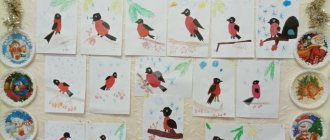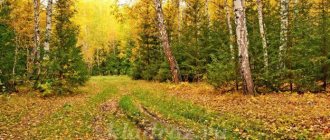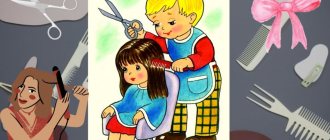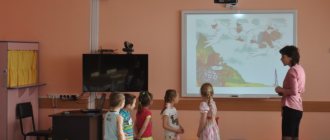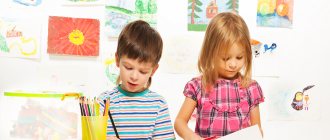GCD on cognitive development “We will see everything, we will learn everything”
Summary of educational activities on cognitive development “We will see everything, we will learn everything”
Subject
: “We will see everything, we will know everything (artificial materials and chemicals are necessary)”
Target
: create conditions for the formation of children’s knowledge about some properties of artificial materials and chemicals.
Tasks:
create conditions for children to study some of the properties of modern materials: rubber, plastic, foam rubber; create conditions for children to study some of the properties of chemicals: soda, acetic acid, washing liquid, dye; create conditions for children to interact with each other, develop curiosity, tactile memory, attention, and thinking; create conditions for children to take care of their health.
Equipment:
plastic cube, rubber ball, foam sponge, rubber balls, plastic bottle, soda, acetic acid, washing liquid, dye, gouache, brushes, pencils, paper, multimedia presentation.
Activation of the dictionary:
artificial materials, rubber, plastic, foam rubber, chemicals.
The course of direct educational activities: Educator:
Hello, guys!
Let's greet each other. Greeting “Let's rejoice”
Let's rejoice at the sun and the birds,
(children raise their hands up)
And also rejoice at the smiling faces
(smile at each other)
And everyone who lives on this planet
(throw up their hands)
“Good morning!”
We will say together (hold hands)
“Good morning!”
- Mom and Dad “Good morning!” - will stay with us. Didactic game “Wonderful bag” Educator:
Guys, look, our wonderful bag has prepared some kind of surprise for you. I wonder what's in it? Close your eyes and touch with your hands. The teacher gives each child the opportunity to touch objects with their hands.
Also an interesting activity in the senior group:
Abstract of the GCD educational area “Cognition” in kindergarten (senior group) “Introducing children to the properties of wood and metal”
Educator:
Damir, what is it? What did you feel, what object was it? Tell us about it: is it hard or soft, smooth or rough, light or heavy? What size, what shape?
The child names and guesses: this object is hard, light, smooth, small; this is a cube.
Educator:
Damir, show the guys the cube. Guys, look and touch, check whether Damir correctly named the signs of the object. Children examine, agree, and add that the cube is blue. They identified this sign with their eyes.
Educator:
Guys, who else wants to give everyone a riddle, name all the signs of an object, but not name it, and we will guess.
Igor, tell the guys about the subject, and let them guess. ( It is round, small, smooth, soft, light.)
Educator:
Guys, what is that hidden in the bag? What does it look like? What happens like this? Children guess.
Educator:
Now let's check who was right. The child takes a ball out of the bag. The children examine him, check whether he really has such signs.
Educator:
The ball is soft, light, smooth, round, red. Reinforce the signs in chorus.
Educator:
Well done boys!
Well then. Let's see what else is left in the wonderful bag. Who wants to guess? Katya, tell the children a riddle, tell them about the object, but don’t name the object. (This object is very soft, light, rough, small, brick-shaped.)
Educator:
What is this? Children's answers.
Educator:
Now let's see if we guessed right or not. The child takes a sponge out of the bag.
Educator:
Guys, let's all check together whether Katya named the signs of the object correctly.
Let's repeat these signs. Children
: The sponge is soft, rough, very light, small, brick-shaped, yellow.
Educator:
Guys, who knows what material these items are made of? Children's answers.
Educator:
What material is the ball made of?
(Made of rubber).
What ball?
(Rubber.)
What is the cube made of?
(Made of plastic.)
What kind of cube?
(Plastic.)
What is the washcloth made of?
(Made of foam rubber.)
What kind of washcloth?
(Foam rubber.)
Educator:
Guys, we already know that wood and leather are natural materials.
Where do you think rubber, plastic, and foam come from? (Children express their guesses.) These materials are obtained artificially. They are called artificial materials
, or synthetic.
Rubber
is a widely used material. It was previously obtained from rubber. This is the resin of special tropical trees. Such plants do not grow in our country, and previously we had to buy rubber in other countries. One day, Russian scientist S.V. Lebedev invented a method for producing artificial rubber. It is a complex chemical process made from alcohol and petroleum. Now this invention is used in many other countries.
Educator:
Guys, what objects do you know that are made of rubber? Children's answers.
Educator:
Guys, what objects are made of plastic? Children's answers.
Educator:
Well done, you named a lot of things.
How attentive you are! There is no plastic in nature. plastic
itself means “plastic mass”. Various substances are chemically mixed, melted, and transformed into a plastic mass like plasticine. This mass is pressed into various shapes on special machines (dishes, combs, parts for equipment, etc.). The cooled part steadily retains its shape.
Foam rubber
It does not exist in nature either; it is also obtained artificially by chemical means.
Fizminutka (game self-massage) “Good mood”
We came to visit the edges and found them with our fingers.
We found a bridge with our fingers and we hopped along it. Let's go down a little lower and breathe on our toes. So we touched the neck and smiled wider. We need to rub our ears so that they don’t hurt anymore. You need to rub your hands so that they don’t hurt anymore. And don’t forget about the back so that we can be slim. Finishing the massage, the children say: “We want to be cheerful, beautiful, healthy.” Didactic game “Settle the Guests”
The teacher offers children pictures depicting objects made from various materials and a three-story cardboard house (hotel).
Educator:
Guests have arrived.
These guests must be accommodated in the house. On the ground floor of the hotel there will be objects made of rubber. The second one is made of plastic. On the third floor - made of foam rubber. Children accommodate guests. Educator:
Well done! Everyone was seated correctly.
Experimental activity Educator:
Now let's play some more.
Look how beautiful the colorful balls are. What are they made of? Children:
Made of rubber.
Educator:
Try to fool them. Children inflate balloons.
Educator:
How beautiful, different in color and shape. Why did they turn out different in shape? Children's answers.
Educator:
The one who was able to blow more air into the ball stretched it more.
If the ball is not tied with a thread, what will happen to it? Children:
He'll deflate.
Educator:
That's right, rubber not only stretches, but also compresses back. Rubber is elastic, elastic. Now let's try to pour water into the ball. Children pour water.
Educator:
What's happening?
Is water not pouring out? Children:
No.
Educator:
This means that rubber does not allow water to pass through, and it also does not allow air to pass through.
Now let's pour water into a plastic glass. What's happening? Is water leaking? Children:
No.
Educator:
This means the plastic is durable and does not allow water to pass through. What if we pour water on a foam sponge? Children experiment.
Educator:
The sponge takes up water, gets all wet, becomes heavy and sinks to the bottom of the basin.
Educator:
Guys, in addition to these chemicals from which plastic, rubber and foam are made, there are many different substances that we use in our lives. For example: various detergents (shampoos, washing powders, soaps), various dyes. As well as substances that can be added when cooking, for example: soda, acetic acid.
We must remember!
Any substances and materials can be dangerous!
For example: unpleasant odor in plastic toys or various acids and food additives. Remember this and never take unfamiliar liquids and powders without the permission of adults, as this is dangerous to human life and health!
Educator:
And now I want to show you an interesting experience.
Damir, remember, when there was a lot of snow outside, you and the guys built a big slide, and at the top of this slide you made a depression and everyone said that it was very similar to a volcano. And you said that you would like to see a volcano erupt. Children:
Yes!
Educator:
Using chemicals we will try to reproduce a volcanic eruption.
I started making a model of the volcano, but didn’t have time. Guys, can you help me finish it? Children:
Yes!
Educator:
Then grab your brushes and paints, let's paint our volcano!
Our volcano model consists of a plastic bottle and cardboard. Now let's make lava for the eruption. Pour water into the bottle, add soda, washing liquid, red dye and acetic acid. Children:
Hurray! Eruption!
Educator:
That's how cool and interesting it turned out! Guys, did you like our lesson? What do you remember most? Children's answers.
Educator:
Now record your observations in your notebooks. Thanks everyone for your work.
